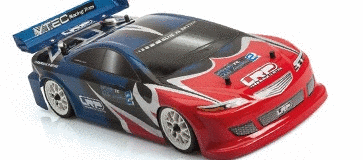Postat 02 September 2006 - 08:54 AM
Am gasit (nu mai stiu unde, dar l-am copiat pe HDD...) un articol despre LiPo care cred ca iti va folosi (am scos foto. din document)
Lithium Polymer Batteries
Brian Mulder
The battery revolution is here . . . well almost. The Lithium Polymer (LiPoly) Cell has arrived and is changing the course of electric flying as people have known it till now. If you told somebody that you were going to pull 20 Amps from a 3-cell pack weighing 156 grams and fly for 8 minutes full tap, they would probably tell you to stop watching the sci-fi channel. Well, the truth is . . . it is reality!
This huge advance in Battery Technology is wonderful, but there are down sides to it as well.
These cells are far more fragile than NiCad or Ni-MH, and if abused, can result in your house or car being burned to the ground.
Am I exaggerating this? Not at all! It has happened a few times and scores of people have had close shaves. This technology has to be treated correctly and the safest way to use them is to acquire as much information as you possibly can about them in order to enjoy in safety the benefits these new cells can provide.
We must also be aware that these cells have not been designed for use in our RC planes, but we want to use them because they are significantly lighter than comparable NiCad or Ni-MH batteries, which makes our planes fly longer and better. Right, so lets look at these cells a little more closely.
The Technology
LiPoly is a variation of the Li-Ion cell, a cell well known for some time now due to its use in cellphones. The primary difference between these two types of cells is in the electrolyte. Li-Ion uses a liquid electrolyte whereas Lipoly uses a gel type electrolyte.
The gel electolyte makes it possible to package the cell in a foil pouch with an outer plastic laminate. This packaging occupies less space and weighs less than the traditional metal can. The foil pouch permits greater space for active material, and it can be readily formed into a shape closely tailored to the space available in the application for which it is intended. Further more, the foil can reduce the cell weight by 50% or more.
The reduction of weight in the packaging however, is not the reason for which these cells are sought after. In fact the packaging is more of a problem for us, but we will get back to that shortly. It is the Power or Energy Density that makes these cells so good.
The table below shows that the Li-Poly packs three to four times the energy of a "normal cell" for the same weight — "energy density".
Physical Properties of Different Types
NiCad NiMH Li-Ion Li-Poly
voltage 1,2 1,2 3,6 3,6
energy density
(by weight) (Wh/kg) 40 60 90 >130
energy density
(by volume) (Wh/litre) 100 140 250 310
self-discharge (/month) 15% 20% 6% 6%
weight (680 mAh) 17g 17g 16,5g 10-14g
Also, a single Li-Poly cell has a nominal voltage of 3,6V as opposed to the standard 1,2V in the cells we know. That means you need one LiPoly for every three normal cells!
The Cell Packaging
Unlike the cylindrical AA or sub C shape we have grown accustomed to, these cells are thin flat devices, packaged in a foil pouch. What is important to understand here is that this pouch can be damaged far more easily than the NiCads we are used to. A crash can easily result in cells being punctured, allowing their electrolyte to ooze out. It is therefore very important that cells are packed correctly in an airframe to minimize damage in the event of a crash. Wrapping them in bundles of foam though, is not the answer. There is another very important parameter we need to cater for, and that is operating temperature.
Operating temperature
As we approach the maximum discharge capacity allowed for any given cell, temperature starts to play a prohibitive role. It is important that we do not exceed the maximum allowed temperature of about 80°C (140 to 160°F) or you will be heading for disastrous consequences.
An important comment here is that John L has on several occasionas published the value of 150°C as the critical temperature. This is well above the boiling point of water and few electronic components would survive long near it. For interest, extracted from JL's teaching knowledge, 60°C is about the highest temperature your fingers can tolerate, so 80°C will give you quite a burn!
Above the "critical temperature" there is a point of no return where "thermal runaway" occurs. Exceed that limit, and no amount of cooling is going to avoid a cell bursting into a ball of fire.
There is a flip side to the temperature issue though. The lithium polymer electrolyte does not like the cold. Its performance increases quite substantially when it operates within certain limits. It has been recommended that battery packs be kept out of the winter cold until they are used. This applies to storage as well. It has also been noted with interest, that multiple cell packs work better than one or two cell packs. The heating of the cells actually helps the other cells within a pack, providing of course you stay within the prescribed limits!
Cell Capacity & Discharge Ratings
Li-Poly is not entirely new. It has been around for a while now, but why they have become so useful lately, is because of the improved discharge rating or ‘C' ratings. First generation cells were only good for up to about 4C discharge (which means a 2600 mAh cell could be discharged at 4 x 2600 mA = 10400 mA or 10,4 A) and resulted in many cells being required in parallel ( * see below) in order to create a battery pack that could provide enough current. This made a pack very costly.
Today, cells are available that are capable of a nominal 8C discharge with a peak of up to 15C in short bursts. These parameters are improving all the time, and 20C has been referred to on various forums. Note however, that certain RC stores in South Africa are still selling the first generation cells and not the newer improved cells.
At the beginning of this article, I mentioned one of the primary advantages of Li-Poly being the energy density. Another great ability of Li-Poly, is the ability to wire them in parallel — a practice not encouraged with NiCad cells. This allows us to create a pack that can supply multiples of ‘C' discharge — I will cover this in the battery pack design example later in the column.
Voltage
Li-Poly has a nominal voltage of 3,6V and is basically considered as a replacement for 3 NiCad cells. The way the cell performs though, is slightly different. A fully charged Li-Poly cell will have a potential of 4,2V and is considered fully discharged when its voltage drops to about 3,0V. Unlike NiCads which hold a fairly constant voltage and die suddenly, Li-Poly will drop its 4,2 to a lower voltage, depending on the load it sees, from where the voltage will drop more slowly than a NiCad before dropping off in a way similar to that of NiCad. The final "dive" part of the discharge slope should not be allowed though. The speed controller must be set up in order to cut the throttle before, or at least at the very start of, the "dive" part of the curve is reached.
Deciding on the number of cells required can be tricky. A Speed-400 6V motor typically runs on a 7-cell pack of 8,4 volts. A 2-cell Li-Poly pack will provide about 7,2 volts under load, which is not quite enough power and a 3-cell pack will provide 10,8 volts, which will very quickly destroy the motor if driven at full power. Also bear in mind that the higher voltage will result in more current being drawn, or a higher C rating used, that could exceed the pack ability.
In this case, you have a couple of options available. The ideal one is to use a motor of suitable voltage, or to use/program your throttle stick to prevent burning the motor.
Currently available cells and dimensions
capacity
(mAh) weight
(g) L
(mm) W
(mm) T
(mm)
500 10,8 63 35 2,5
850 17,0 63 35 3,6
1100 21,8 63 35 5,0
1800 34,0 89 56 3,3
2200 42,5 89 56 3,8
2600 51,9 89 56 4,5
To give some perspective to the size of these cells, here are two views of the 1100 mAh version.
Creating a Battery Pack
Now that we have covered the basics, let's create a pack in order to bring together the points discussed.
First off, we must determine what our power requirement is. This is normally the wattage required in order to fly the airplane. We will not concern ourselves about this now, as that is a whole different subject, but let's assume Motocalc software predicts that we need 300 watts of input power.
The first step is to choose a pack voltage. This decision is normally based on what power converter (your motor) you have available.
To ease calculations, let's say we need 10V. So in order to achieve 300 watts input power, our current consumption will have to be 30 amps.
Power = Current x Voltage. Great, so let's select a cell from the table above.
The biggest cell available has a capacity of 2600 mAh. At a nominal discharge rating of 8C, the cell is capable of delivering almost 21 amps. This figure does not meet our 30 amp requirement — but if we can run two cells in parallel, then our discharge rating is doubled to 42 amps. Now we're talking!! As we only need 30 amps, each cell will provide 15 amps, resulting in a cooler, less stressed cell. (If only we had a resident artist to sketch a picture of a "stressed cell"!!! JL)
As for voltage, three cells will give us 9 volts in the discharged state and in excess of 12 volts in the fully charged state. So in order to complete the pack, we will need a total of six cells, consisting of three cells in series, connected in parallel with another three cells in series. If you have read anything about Li-Poly cells then you will have seen notations like 3s2p — meaning 3 series 2 parallel.
Overall capacity of our pack will be 5400 mAh and will supply 30 amps for a staggering 10 minutes at full power. Not bad. If you use your throttle stick conservatively, then those 10 minutes start stretching towards 20 minutes or more. Even better!!
But hang on . . . that additional current comes at a cost — weight. Could we not make up a pack using smaller cells that still meets the required C rating?
Yes indeed you can! The 1800 mAh cells, rated at 8C can deliver 14,4 amps. Two of these will come close to providing the current required. And this is when power management comes into play — the cell might be rated at 8C, but they can be pushed beyond that for short periods to give the required 15 amps each and 30 amps total.
The weight of six 1800 mAh cells is 204 g, where six 2600 mAh cells weigh 311 g!
The Charging Process
And here lies the big danger. If you visit RCGroups.com and do a search for Li-Poly and Fire, you will find scores and scores of hits relating to personal experiences. You can even download MPEGs or AVIs of Li-Polys going bang under charge. And it isn't a pretty sight! Some people actually resort to charging their cells in old metal ammo boxes or porcelain dishes. Even the kettle braai is being used!!! Do you need to resort to this? Not really, but if you want to play absolutely safe, it is recommended to place you battery pack in some kind of fire-containing box.
So what's up with the charging process then?
The charge process is surprisingly simple. It's even easier than NiCad for that matter — but it's different!
Just to refresh, a NiCad is charged with a constant current and monitored for what we call a delta peak. When the peak is detected, the charge cycle is switched off or continued with a trickle charge. With Li-Poly, a constant current is also used, (1C) but the charge is terminated at 4,2 volts. No delta peak is looked for — just a voltage level. I have used my own current limiting power supply to charge my cells. I set the voltage to 12,6 volts (3 cell pack) and adjust the current limit to about 1C or less When charging the cells, the current limiting pulls the voltage down, which then slowly rises as the cells charge. On reaching the set voltage, the current simple dies away. Easy as pie!
So then, what's the problem or danger you ask?
Answer . . . Cell Balancing.
When multiple cells are charged together, ideal cells will have their voltage rise equally over time. I have monitored mine and they are within 0,01 volt of each other at present. Problem is, as they age, the pack can become unbalanced.
What happens is that one or two cells in a 3-cell pack may rise more slowly than a good cell. By the time the two lower cells reach a voltage of 4V, the good cells have already exceeded the 4,2 volt allowed and started to balloon . . . which by the way, is the sign of impending failure and a possible fireball!
The simple fact is, no cell must be allowed to exceed its voltage limit.
It's that critical. Period!!
The other problem with charging these cells is the human element and chargers that are too clever for themselves. The human element is about programming wrong parameters into a charger, the most common being the incorrect number of cells or too high a charging current. Either of these can have disastrous results.
Hi tech chargers can also get it wrong. They read the pack voltage and try determining how many cells it sees. If the pack has been discharged too deeply, the number of cells seen could be incorrect. No need to say more.
The following text sums up everything you need to know about Li-poly.
It is taken from RC Groups under a thread title of —
Ultimate Guide to Lithium Polymer Batteries
1 Use only a charger approved for lithium batteries.
2 Make certain that the correct cell count is set on your charger.
3 NEVER charge the batteries unattended. This is the number one reason for houses and cars being burned to a crisp by lithium fires.
(There is in effect no such thing as a fully automated Lithium battery charger! JL)
4 Use a safe surface to charge your batteries on so that if they burst into flame, no damage will occur. Vented fire safes, pyrex dishes with sand in the bottom, fireplaces are all good options.
5 Do Not charge at more than 1C.
6 If a cell balloons while charging DO NOT puncture the cell while it is still hot! Put the cell/pack in salt water and wait until it has cooled. Once it is cool gently puncture the pack's outer casing and put it back in the salt water. After this, the cell is safe to throw in the garbage.
7 VERY IMPORTANT — If you crash with your lithium cells they may be damaged in such a way that they are shorted inside. The cells may look just fine. If you crash in ANY way carefully remove the battery pack from the airplane and watch it carefully for at least the next 20 min. Several fires have been caused by damaged cells being thrown in the car and then the cells catch fire later and burns the car completly.
8 Charge your batteries in a open, ventilated area. If a battery does rupture or explode, hazardous fumes and material will spew from the battery.
9 Keep a bucket of sand nearby when you are flying or charging batteries. This is a cost effective way to extinguish fires. This is very cheap and absolutly necessary.
10 Realize that these batteries are dangerous. Do not think to yourself that "It won't happen to me" — as soon as you do that it will happen to you and you'll be trying to rescue your kids from your burning house or car.
General usage tips
1 Lithium batteries don't work well in cold air. If you are flying in the winter, keep the batteries in your car until you're ready — this will ensure best performance.
2 Don't let the batteries overheat. Try to keep them under 80°C. This will prolong your battery life.
3 Don't push the batteries past their rated maximum C rating. This will damage the battery and the apparent capacity of the batteries will drop. If, when you recharge you are only putting 1/2 to 3/4 of the rated capacity back into the batteries, you are probably pushing them too hard.
4 Monitor the voltage of individual cells. Keeping all cells in the pack at exactly the same voltage is important for both the safety and long life of your batteries.
5 If you're building your own cells then put spacing between each cell in the pack to help cooling of the pack. This is most important when building packs larger than two cells.
6 Some Li-Poly cells use aluminum tabs that you must solder leads to. Normal soldering procedures will not work on aluminum. You'll need to purchase aluminum soldering paste. The vendor where you purchased your aluminum tab cells should stock this paste.
Happy Flying!!
Brian

 Ajutor
Ajutor


 Raspuns nou
Raspuns nou



 Citare Multipla
Citare Multipla














